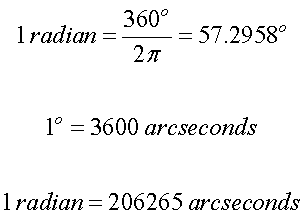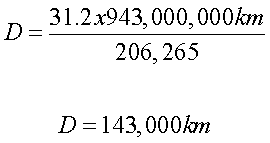Some objects in the sky have an apparent size - like
the
moon. By understanding geometry and the nature
of circles, it is possible to determine the distance
to the object, or the physical diameter of the
object.With regard to measure, the standard in
Astronomy is degrees and arcseconds. Here is the
conversion factors:

As an example of this equation in use, I will use
the example shown in the
reference text:
To determine the physical diameter of
Jupiter (on
July 26, 2003), we can use what is called the small
angle formula:

D = linear (physical) diameter
α = angular size
in arcseconds = known for
Jupiter 31.2 arcseconds
d = distance to object = known for
Jupiter =
943,000,000 km
206,265 = is required (arcseconds per radian)

This is in good
agreement with the actual diameter of
Jupiter (142,984km).
Back to Top
|

